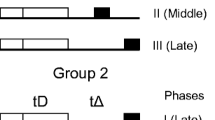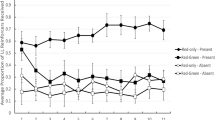Summary
The concept of an optimal level of stimulation as an explanation for the reinforcing effects of weak light onset was explored in four experiments. Experiment I employed 4 groups of 8 rats each and demonstrated that the Ss would respond at higher levels to obtain weak illumination than to terminate weak illumination. Experiment II involved a group of 8 rats subject to the same level of illumination. By choosing between appropriate levers the animals could either put the test cubicle in darkness for 2 sec. or increase the illumination level for 2 sec. All Ss showed a preference for increasing the illumination. Experiment III introduced a “novelty effect” in that the position of the illumination source changed in response to lever pressing. The Ss’ behavior indicated that this effect was not reinforcing. Experiment IV was designed to study the influence of increased drive on the reinforcing effect of weak light. Results were inconclusive although the trend was in the predicted direction. The ad lib group tended to make more responses to the lever activating the light source than did the deprivation (high drive) group. Results of the four experiments were sufficiently supportive of the hypothesis to suggest that further investigation would be fruitful.
Similar content being viewed by others
References
BARNES, G. W., KISH, G. B., and WOOD, W. O. The effect of light intensity when onset or termination of illumination is used as reinforcing stimulus. Psychol. Rec., 1959, 9, 53–60.
DAVIS, J. D. The reinforcing effect of weak light onset as a function of amount of food deprivation. J. comp. physich. Psychol., 1958, 51, 496–498.
HEBB, D. O., and THOMPSON, W. R. The social significance of animal studies. In G. Lindzey (Ed.), Handbook of social psychology. Cambridge: Addison-Wesley, 1954.
HURWITZ, H. M. B., and DE, S. G Studies in light reinforced behavior: II. Effect of food deprivation and stress. Psychol. Rep., 1958, 4, 71–77.
KISH, G. B. Learning when the onset of illumination is used as reinforcing stimulus. J. comp. physiol. Psychol., 1955, 48, 261–264.
KLING, J. W., HOROWITZ, L., and DELHAGEN, J. E. Light as a positive reinforcer for rat respondng. Psychol. Rep., 1956, 2, 337–340.
LEUBA, C., Toward some integration of learning theories: The concept of optimal stimulaton. Psychol. Rep., 1955, 1, 27–33.
MARX, M. H., HENDERSON, R. L. and ROBERTS, C. L. Positive reinforcement of the bar-pressing response by a light stimulus following dark operant pretests with no aftereffect. J. comp. physiol. Psychol., 1955, 48, 73–76.
MUNN, N. L. Handbook of psychological research on the rat. New York: Houghton Mifflin, 1950.
ROBERTS, C. L., MARX, M. H. and COLLIER, G. Light onset and light offset as reinforcers for the albino rat J. comp. physiol. Psychol., 1958, 51, 575–579.
Author information
Authors and Affiliations
Additional information
Data collection for this study was carried out while the author was at the Bureau of Research in Neurology and Psychiatry, NJNPI, Princeton, New Jersey.
Rights and permissions
About this article
Cite this article
Wilson, J.J. Photic reinforcement as a function of optimal level of stimulation. Psychol Rec 12, 17–23 (1962). https://doi.org/10.1007/BF03393435
Published:
Issue Date:
DOI: https://doi.org/10.1007/BF03393435




